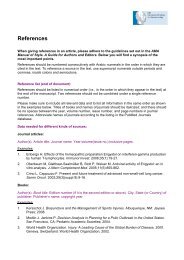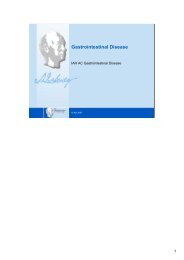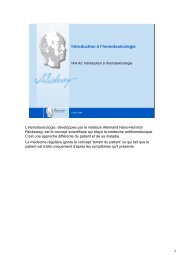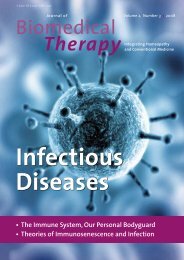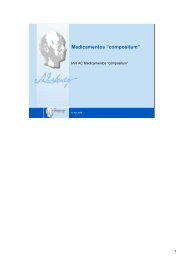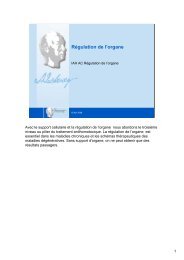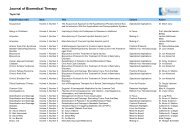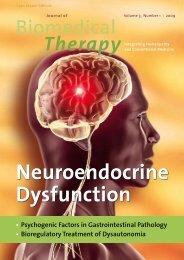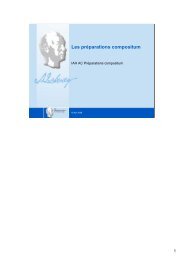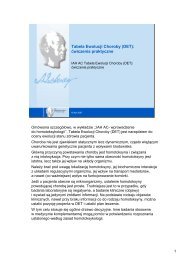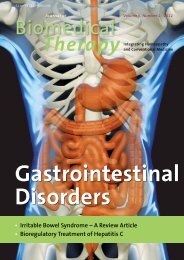Metabolic Syndrome - International Academy of Homotoxicology
Metabolic Syndrome - International Academy of Homotoxicology
Metabolic Syndrome - International Academy of Homotoxicology
Create successful ePaper yourself
Turn your PDF publications into a flip-book with our unique Google optimized e-Paper software.
) From the Practice<br />
Immediate Intervention Required!<br />
Prophylaxis in a Male Patient With<br />
Early-Stage <strong>Metabolic</strong> <strong>Syndrome</strong><br />
By Ulrike Keim, MD<br />
Specialist in internal medicine<br />
) 12<br />
Previously, Mr. B. E. had visited my <strong>of</strong>fice only occasionally,<br />
during the spring allergy season, when he suffered from<br />
bronchial asthma. In February 2007, however, he reported<br />
having been hospitalized for a week for treatment <strong>of</strong> sudden<br />
deafness and tinnitus in his left ear. Cortisone treatment<br />
and rheological infusion therapy had restored his hearing,<br />
but the tinnitus continued to bother him. Overall, he felt<br />
unmotivated and physically weak.<br />
This 63-year-old patient was<br />
overweight, with a body-mass<br />
index <strong>of</strong> thirty and a waist circumference<br />
<strong>of</strong> 104 cm (41 in). His liver<br />
was palpably fatty and s<strong>of</strong>t to the<br />
touch. Other findings were unremarkable;<br />
his pulse was regular and<br />
his reflexes normal. Lab test results<br />
were indicative <strong>of</strong> early-stage metabolic<br />
syndrome bordering on type 2<br />
diabetes (see Table 1).<br />
Four major interventional studies<br />
conducted in recent years all came<br />
to the same conclusions on how development<br />
<strong>of</strong> type 2 diabetes can be<br />
prevented in cases <strong>of</strong> metabolic syndrome<br />
such as this one (see Table<br />
2).<br />
After nutritional counseling, the<br />
patient changed his eating habits<br />
significantly, reducing his consumption<br />
<strong>of</strong> animal fats in particular. Mr.<br />
B.E. was well aware that he stood at<br />
the crossroads: Either he would have<br />
to adopt a more health-conscious<br />
lifestyle and undergo holistic homeopathic<br />
treatment, or the metabolic<br />
syndrome would develop into<br />
full-fledged type 2 diabetes. Due to<br />
the “demands <strong>of</strong> his job,” as the patient<br />
put it, he was unable to implement<br />
the recommended exercise<br />
program. 1<br />
In addition to advising lifestyle<br />
changes, I developed a treatment<br />
program for the patient that focused<br />
on his microcirculatory disorders<br />
(which were already pronounced)<br />
and the following risk factors:<br />
• hypercholesterolemia<br />
• hypertriglyceridemia<br />
• excess weight<br />
• borderline erythrocyte<br />
and hematocrit values<br />
• impaired glucose tolerance<br />
Treatment model<br />
Mr. B.E. received the following basic<br />
treatment for metabolic syndrome<br />
(see also Figure 1):<br />
1. Syzygium compositum is the<br />
basic medication in antihomotoxic<br />
treatment <strong>of</strong> metabolic syndrome,<br />
especially in elderly and debilitated<br />
patients. Its main ingredient is the<br />
seed <strong>of</strong> the jambul or black plum<br />
(Syzygium cumini), which grows in<br />
Malaysia, India, and the tropical<br />
parts <strong>of</strong> China. It has been known<br />
since the nineteenth century for its<br />
ability to reduce blood sugar. Syzygium<br />
compositum’s other ingredients,<br />
selected for their complementary<br />
effects, include:<br />
• Acidum phosphoricum and<br />
Aci dum sulfuricum, for their<br />
strengthening effects in debility<br />
• Hepar suis and Pankreas suis,<br />
for their organ-strengthening<br />
effects<br />
• Strychnos ignatii, for its benefits<br />
in states <strong>of</strong> psychological stress<br />
and worry<br />
1<br />
Endurance sports such as bicycling and swimming are most effective; Nordic walking is the best <strong>of</strong> all.<br />
Journal <strong>of</strong> Biomedical Therapy 2008 ) Vol. 2, No. 1



